Fort Assiniboine
Fort Assiniboine is a hamlet in northwest Alberta, Canada, within Woodlands County.[1] It is located along the north shore of the Athabasca River at the junction of Highway 33 and Highway 661. It is approximately 39 kilometres (24 mi) northwest of Barrhead, 62 kilometres (39 mi) southeast of Swan Hills and 91 kilometres (57 mi) northeast of Whitecourt.
Fort Assiniboine | |
|---|---|
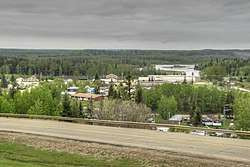 Skyline and the Athabasca River | |
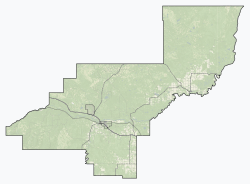 Fort Assiniboine Location in Woodlands County 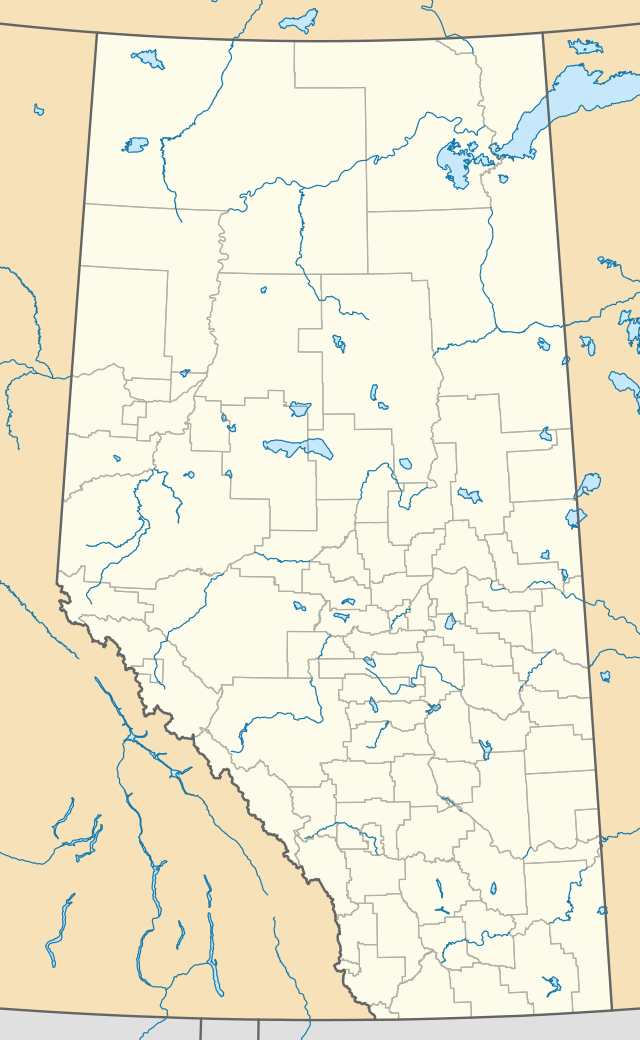 Fort Assiniboine Location in Alberta | |
| Coordinates: 54.3342°N 114.7747°W | |
| Country | Canada |
| Province | Alberta |
| Region | Northern Alberta |
| Planning region | Upper Athabasca |
| Municipal district | Woodlands |
| Government | |
| • Type | Unincorporated |
| • Governing body | Woodlands County Council |
| Area | |
| • Total | 0.73 km2 (0.28 sq mi) |
| Population (2016) | |
| • Total | 176 |
| Time zone | UTC−7 (MST) |
| • Summer (DST) | UTC−6 (MDT) |
| Fort Assiniboine | |
|---|---|
| Type | Fort |
| Location | Barrhead, Alberta, Canada |
| Nearest city | Edmonton |
| Elevation | 604 m (1,982 ft) |
| Governing body | Woodlands County Council |
Fort Assiniboine was founded as a trading post by the Hudson's Bay Company and became a stopping point along the Klondike Trail. It gets its name from the Assiniboine people. The fort itself no longer exists, but the land on which it stood is designated as a National Historic Site for its archaeological value.[2] The hamlet, built on and around the site of the fort is a now a local hub for the surrounding agricultural region.
History
Local oral history tells of an early (possibly late 1700s) North West Company fur trading post south of Holmes Crossing (an early ferry crossing) on the Athabasca River.[3] In 1821, the North West Company was merged with Hudson's Bay Company (HBC), who then undertook to reorganize its transportation routes, seeking out advantages and efficiencies in its operations. By then, trade on Lesser Slave Lake was in decline and the council adopted a resolution in 1823 calling for a fort further up the Athabasca River to reduce transport times. Under the new plan, Fort Assiniboine on the Athabasca River (the fort was originally named 'Athabaska River House'[4] ) became the northwest end of an overland 129 kilometres (80 mi) horse track to Edmonton House/Fort Edmonton, cut by Jacques Cardinal, a Métis free trader, in 1824-25. The trail became known as 'The Hudson Bay Packtrail'.This provided a straighter route from Jasper House and the Athabasca Pass within the Rocky Mountains to York Factory on Hudson Bay. A party on horseback could make the trip from Edmonton to Fort Assiniboine in two to six days, depending on conditions.[5] The new post opened in 1824.[3][4]
The new route was used by the York Factory Express. The old canoe route involved going far north-northeast up the Athabasca to Fort Chipewyan and then southeast through Methye Portage to Lake Winnipeg. Though the fort never grew as large as some other Alberta forts, its role as a transportation hub and provision centre ensured its survival between the 1820s and 1880s.[6] The fort burned to the ground after its abandonment by the Hudson Bay Company.[2] No plans existed for its original layout, but, using clues from post administrators' log books and archaeological surveys, a replica was built on the site in 1980. It operates as a museum and friendship centre.[7]
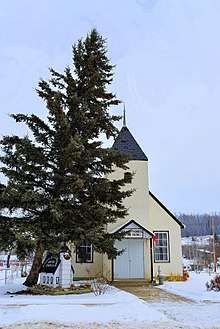
In 1898, when the Chalmers, or Klondike Trail was cut through the Swan Hills, northwest of Fort Assiniboine to Lesser Slave Lake, the location again became a stopping point, with gold seekers crossing the river with a self-service ferry on their overland trek to the Yukon.[8][9]
The earliest homesteads in the area were filed in 1906 in the Holmes Crossing district (named for the ferryman William B. Holmes), across the Athabasca and downriver from Fort Assiniboine. Most came via Edmonton, by way of the Hudson's Bay Pack Trail, which had been widened by then to accommodate wagons and sleights. The graded road only went to about 16 km (10 miles) west of Morinville. By 1908 settlers crossed on the ferry and took up land north of the Athabasca River, including around the site of the old fort. The Fort Assiniboine post office was set up in 1910, operated, as was the practice, from a local homestead. Joseph Brewster was the first postmaster. A blacksmith's shop, and a store were soon built near the fort site. In 1914, the railway was built to Westlock, shortening the route on the trail significantly.[3]
The first community hall was built in 1916. By 1919, the road was graded to Holmes Crossing. The next year, on the north side of the river, a road was graded from the ferry landing, to a bridge on the Freeman River west of Fort Assiniboine. In 1922, the post office was moved to the settlement. The quarter-section of land on which the trading post had been situated had been homesteaded by a Dr. E.J. State in 1913. When he died in 1923, his property was willed to the University of Alberta, who surveyed and sold the lots, expanding the hamlet. In 1927 the railroad was built to Barrhead, only 40 kilometres (25 miles) away.[3]
In 1934 the Provincial government set up a public nursing service in the hamlet, which operated until 1969. The surrounding schools were centralised to Fort Assiniboine in 1946 and in the same year a charter was issued for a Fort Assiniboine Branch of the Royal Canadian Legion. A United Church and a Roman Catholic Church were built in 1948 and 1949. The curling club was formed and a rink built in 1953. In 1956 a bridge was built over the Athabasca River, putting the ferry out of business.[3]
Fort Assiniboine was a hamlet until incorporated as a village in 1958. E.M. (Gene) Redington was the first Mayor. The Village of Fort Assiniboine dissolved and reverted to hamlet status on December 31, 1991. It is now administered by Woodlands County, which has offices in the hamlet and in the Town of Whitecourt.
Notable people who passed through Fort Assiniboine during fur trade days
During its years as an important transportation hub between Edmonton and Lesser Slave Lake, and Edmonton and the Rocky Mountains along the Athabasca River, many explorers, missionaries and other notable people passed through the fort, confirmed by reports and diaries.
- David Thompson - explorer
- John Rowand - factor at Fort Edmonton
- Sir George Simpson - Governor in Chief of the Hudson's Bay Company
- Dr. John McLoughlin - Hudson's Bay Company factor and Superintendent
- Alexander Ross - fur trader
- Paul Kane - Irish-Canadian painter
- Pierre-Jean de Smet - Catholic missionary
- Robert Rundle - Methodist missionary
- Alfred Garrioch - Anglican priest
- John Macoun - Irish-Canadian naturalist
Demographics
As a designated place in the 2016 Census of Population conducted by Statistics Canada, Fort Assiniboine recorded a population of 176 living in 78 of its 83 total private dwellings, a change of 13.5% from its 2011 population of 155. With a land area of 0.73 km2 (0.28 sq mi), it had a population density of 241.1/km2 (624.4/sq mi) in 2016.[10]
Attractions
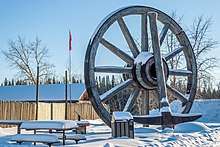
Fort Assiniboine is home to a Hudson Bay style historical museum, known as the Fort Assiniboine Museum and Friendship Club Drop-In Centre, and the "World's Largest Wagon Wheel and Pick Axe".[11] A boat launch east of the hamlet provides river-boaters access to the Athabasca River. There is also a private R.V. park and marina, which hosted the Athabasca River Voyageur Canoe Bridade[12] in June 2017, celebrating Canada's 150th birthday.[13][14] A farmer's market is held every Friday afternoon from May to September[15] in the Recreation and Agriculture Building, which also hosts agricultural and sports events throughout the year including the annual Hamlet Hoedown Rodeo & Fair, held each August.[16]
Services
The Fort Assiniboine School, which offers kindergarten through Grade 9, is located within the hamlet.[17] Students in Grades 10-12 are bussed to Barrhead Composite High School.[18] Both are administered by Pembina Hills Public Schools] (PHPS).[19] Fort Assiniboine is also served by a post office and the Fort Assiniboine Public Library.[20] It has numerous businesses including a general store, a motel, a gas station, a liquor store and a shop that repairs and sells all-terrain and other vehicles.
Climate
| Climate data for Fort Assiniboine | |||||||||||||
|---|---|---|---|---|---|---|---|---|---|---|---|---|---|
| Month | Jan | Feb | Mar | Apr | May | Jun | Jul | Aug | Sep | Oct | Nov | Dec | Year |
| Record high °C (°F) | 13.0 (55.4) |
17.0 (62.6) |
17.0 (62.6) |
29.5 (85.1) |
34.0 (93.2) |
33.3 (91.9) |
32.0 (89.6) |
33.0 (91.4) |
33.0 (91.4) |
29.0 (84.2) |
18.5 (65.3) |
13.3 (55.9) |
34.0 (93.2) |
| Average high °C (°F) | −8.2 (17.2) |
−3.3 (26.1) |
2.9 (37.2) |
11.3 (52.3) |
17.5 (63.5) |
20.7 (69.3) |
22.5 (72.5) |
21.4 (70.5) |
16.1 (61.0) |
10.4 (50.7) |
−1.1 (30.0) |
−7.7 (18.1) |
8.5 (47.3) |
| Daily mean °C (°F) | −14.8 (5.4) |
−10.8 (12.6) |
−4.2 (24.4) |
3.7 (38.7) |
9.7 (49.5) |
13.5 (56.3) |
15.6 (60.1) |
14.4 (57.9) |
9.1 (48.4) |
3.4 (38.1) |
−6.7 (19.9) |
−13.9 (7.0) |
1.6 (34.9) |
| Average low °C (°F) | −21.4 (−6.5) |
−18.2 (−0.8) |
−11.3 (11.7) |
−3.9 (25.0) |
1.9 (35.4) |
6.3 (43.3) |
8.6 (47.5) |
7.4 (45.3) |
2.1 (35.8) |
−3.5 (25.7) |
−12.3 (9.9) |
−20 (−4) |
−5.4 (22.3) |
| Record low °C (°F) | −48 (−54) |
−47 (−53) |
−38.9 (−38.0) |
−30 (−22) |
−8.5 (16.7) |
−2.8 (27.0) |
1.7 (35.1) |
−4 (25) |
−11 (12) |
−30 (−22) |
−38.3 (−36.9) |
−46 (−51) |
−48 (−54) |
| Average precipitation mm (inches) | 18.6 (0.73) |
15.5 (0.61) |
16.1 (0.63) |
24.0 (0.94) |
48.9 (1.93) |
105.3 (4.15) |
118.7 (4.67) |
83.2 (3.28) |
44.0 (1.73) |
16.9 (0.67) |
18.6 (0.73) |
23.4 (0.92) |
533.1 (20.99) |
| Source: Environment Canada[21] | |||||||||||||
See also
References
- Alberta Municipal Affairs (2010-04-01). "Specialized and Rural Municipalities and Their Communities" (PDF). Archived from the original (PDF) on 2012-02-29. Retrieved 2010-07-10.
- "HistoricPlaces.ca - HistoricPlaces.ca". historicplaces.ca. Retrieved 2017-08-09.
- Echoes of Fort Assiniboine and districts. Fort Assiniboine Friendship Club. Book Committee. Fort Assiniboine, Alta.: Fort Assiniboine Friendship Club Book Committee. 1982. pp. 2, 4. ISBN 0889252483. OCLC 10666654.CS1 maint: others (link)
- McCarty, Richard Frances (1976). Fort Assiniboine, Alberta, 1823-1914 : fur trade post to settled district. Edmonton, Alberta: University of Alberta. p. 13.
- McCarty, Richard (1975). Fort Assiniboine 1823-1860 : Hudson's Bay Company Way Station and Fur Trade Post. History 501 Honors Essay. Edmonton: University of Alberta.
- Losey, Elizabeth Browne (1999). Let them be remembered: the story of the fur trade forts. New York: Vantage Press. pp. 481–486. ISBN 978-0-533-12572-2. OCLC 44722618.
- "Fort Assiniboine Museum". Woodlands County. Retrieved 2017-08-09.
- 1957-, Larmour, Judy (2005). Laying down the lines : a history of land surveying in Alberta. [Calgary]: Brindle & Glass Pub. ISBN 9781897142042. OCLC 57528191.CS1 maint: numeric names: authors list (link)
- "Klondike Trail Society - Chalmers Trail". archive.li. 2008-12-21. Archived from the original on 2008-12-21. Retrieved 2017-08-09.
- "Population and dwelling counts, for Canada, provinces and territories, and designated places, 2016 and 2011 censuses – 100% data (Alberta)". Statistics Canada. February 8, 2017. Retrieved February 13, 2017.
- Woodlands County. "About Fort Assiniboine". Retrieved 2010-03-27.
- "Athabasca River Voyageur Canoe Brigade | June 22 -> 28, 2017 | Voyageur Brigade Society". voyageurbrigade.org. Retrieved 2017-08-09.
- "Reenacting a part of Canadian history". Barrhead Leader. Retrieved 2017-08-09.
- nurun.com. "Athabasca River Brigade lands in Whitecourt". Whitecourt Star. Retrieved 2017-08-09.
- "Fort Assiniboine Farmers Market in Fort Assiniboine Alberta profile at farmers market online". www.farmersmarketonline.com. Retrieved 2017-08-09.
- "Fort Assiniboine Hamlet Hoedown Rodeo & Fair | Wild Alberta". Wild Alberta. Retrieved 2017-08-09.
- Pembina Hills Regional Division No. 7. "Fort Assiniboine School". Retrieved 2010-03-27.
- Barrhead Composite High School
- Pembina Hills Public Schools (PHPS)
- Fort Assiniboine Public Library
- "Canadian Climate Normals 1971-2000". Historical Climate Data. Environment Canada. Retrieved 1 August 2016.